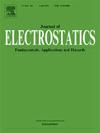利用响应面方法优化空气辅助静电喷涂装置的性能
IF 1.9
4区 工程技术
Q3 ENGINEERING, ELECTRICAL & ELECTRONIC
引用次数: 0
摘要
开发了空气辅助静电喷涂装置和测量喷涂电流的装置。采用响应面方法对所开发的静电喷涂装置的性能进行了优化。电极直径、电极电压、电极位置和目标距离等最佳参数被确定为 30 毫米、2000 伏特、0 毫米和 400 毫米,以最大限度地提高电荷质量比(CMR)。此外,与不带电喷雾相比,带电喷雾的液滴沉积量增加了 1.5 至 4.6 倍,但均匀系数(2.13-2.14)和相对跨度系数(0.84-0.9)较低。本文章由计算机程序翻译,如有差异,请以英文原文为准。
Performance optimization of an air-assisted electrostatic spraying unit using response surface methodology
An air-assisted electrostatic spraying unit along with a set-up to measure the spray current was developed. Response surface methodology was used to optimize the performance of the developed electrostatic spraying unit. The optimum parameters such as electrode diameter, electrode voltage, electrode position and target distance for maximizing charge-to-mass ratio (CMR) were determined to be 30 mm, 2000 V, 0 mm and 400 mm, respectively Predicted CMR under optimal conditions was experimentally validated. Furthermore, charged spray demonstrated 1.5 to 4.6 times higher droplet deposition with lower uniformity coefficient (2.13–2.14) and relative span factor (0.84–0.9) compared to uncharged spray.
求助全文
通过发布文献求助,成功后即可免费获取论文全文。
去求助
来源期刊

Journal of Electrostatics
工程技术-工程:电子与电气
CiteScore
4.00
自引率
11.10%
发文量
81
审稿时长
49 days
期刊介绍:
The Journal of Electrostatics is the leading forum for publishing research findings that advance knowledge in the field of electrostatics. We invite submissions in the following areas:
Electrostatic charge separation processes.
Electrostatic manipulation of particles, droplets, and biological cells.
Electrostatically driven or controlled fluid flow.
Electrostatics in the gas phase.
 求助内容:
求助内容: 应助结果提醒方式:
应助结果提醒方式:


